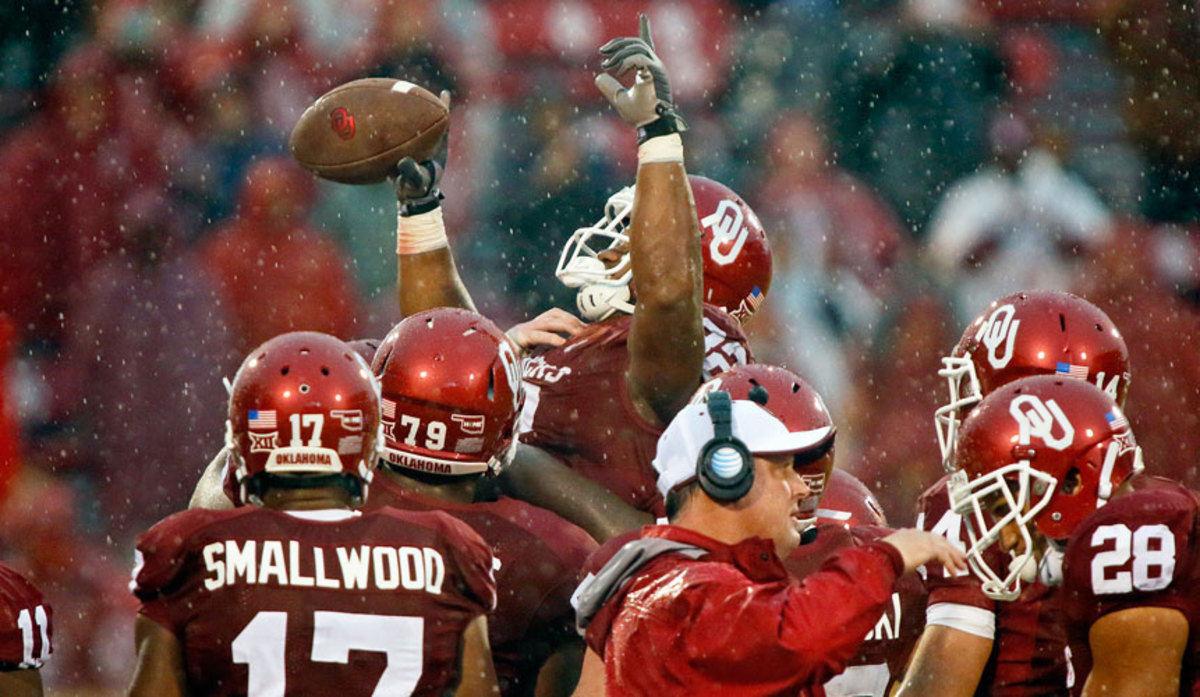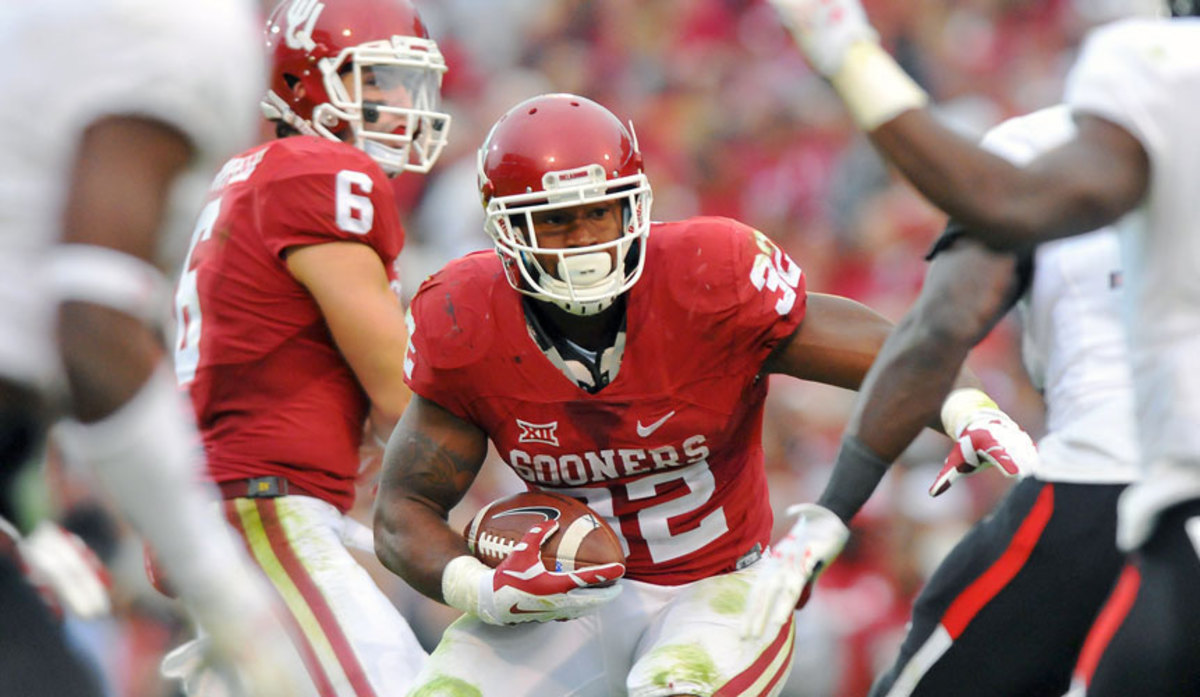New offense, same Samaje: For Oklahoma to make a run at the playoff, it will rely on Samaje Perine to carry it

NORMAN, Okla.—Ty Darlington wasn't having it.
Oklahoma's center overheard his running back talking to coaches, and he set the freshman straight: No, he told Samaje Perine, then a 19-year-old. You're not coming out of this game just yet.
The Sooners were in the midst of blowing out Kansas in the driving rain last Nov. 22. The offense was on its way to rushing for 510 yards—a high in coach Bob Stoops's tenure—behind Perine, a 5' 10", 230-pounder with a tendency to plow over would-be tacklers. With a double-digit lead and the clock dwindling (Oklahoma was in control long before the 44–7 score was finalized), Perine figured it was time to head to the bench. Darlington had other plans. They were going for the record, he told his teammates. So, everyone create running lanes for Perine.
Here is Perine's recollection of the day: "At the time, I was just miserable. I hate playing in the rain. I much prefer the snow. Rain makes me feel like I'm 300 pounds, and I've never liked it. With snow, you're cold, but you can shake that off. You can't shake off feeling wet and heavy. I do remember the smiles on the faces of my offensive linemen. They were probably 10 times as excited as I was."
That's because, by game's end, the newcomer from Pflugerville, Texas, had totaled 427 rushing yards on 34 carries, an FBS single-game record. The number alone was astonishing. But more impressive, it came just one week after Wisconsin's Melvin Gordon, a 2014 Heisman Trophy finalist, had rewritten the record books by running for 408 yards in a rout of Nebraska. After hitting the new high, Perine bought those five smiling linemen five pizzas, a gesture of appreciation for a group often lost in the shadows of a terrific ground attack. He credits Darlington and company with creating opportunity, and anticipating it: A week earlier, on the bus ride home from a 42–30 win at Texas Tech, players read the Gordon news aloud on their phones, then tapped the Oklahoma freshman's shoulders and said he was next.

Brett Deering/Getty Images
Close to exactly one year after that game, Perine still isn't convinced his dominant performance at Kansas was the best of his collegiate career. That distinction, he says, goes to last week's 44–34 victory at Baylor, when he carried 28 times for 166 yards and two touchdowns. His numbers don't jump off the page. But big blocks, key pass protection and one catch made him more of an all-around threat, and that versatility has helped No. 7 Oklahoma (9–1), which hosts No. 18 TCU (9–1) this week, become a contender to represent the Big 12 in the College Football Playoff.
And to think: Just a few months ago, Sooners fans spent the off-season wringing their hands, worrying about what was coming next for Perine and his teammates.
Perine burst on to the college football scene last year, a highly rated recruit who took virtually no time to adjust to the next level. Still, he did so in a fashion he prefers: quietly. Heading into the Kansas game, he averaged just 100 yards per contest, seesawing between huge outputs (34 carries for 242 yards with four touchdowns in a 45–33 win at West Virginia on Sept. 9) and ho-hum performances (18 rushes for 62 yards with one score in a 31–26 win over Texas on Oct. 11). He didn't even start against the Jayhawks. By season's end, he was named second-team All-America, averaging 131.8 yards per game.
Then Stoops, dealing with the aftermath of a disappointing 8–5 campaign that culminated with a 40–6 loss to Clemson in the Russell Athletic Bowl, revamped his coaching staff. In a philosophical shift, he brought in Air Raid tactician Lincoln Riley from East Carolina to modify the offense. Where was the star tailback—soon to be joined by another backfield standout in redshirt freshman Joe Mixon—to go?
Perine says he always took the 40,000-foot, optimistic view. "That's actually beneficial to us as running backs, because it spreads the box out," he says of the new-look offense. "Last year, we had eight- or nine-man boxes. This year, it's five or six."
Midway through the spring, Perine decided he liked the switch, convinced Riley knew how to incorporate every type of playmaker. He didn't stress about his still-to-be-determined role, but recognized the need to become a better receiver if he wanted to survive in a pass-heavy scheme. Each practice, he stayed late to catch tennis balls—fired from a machine—aiming to corral 45 of 50 shot at him. And while outsiders fretted about how Riley would use him Perine, Riley watched film on the back and took note of his skill set.
"Everybody in college football knew what type of runner he was last year," Riley says. "Now, he's showing everybody that he can be more than a guy you hand it to and just have him pound it play after play." In this season's model, Perine can play every down—even if he isn't taking handoffs.
While the Sooners have relied heavily this fall on dark-horse Heisman candidate and Texas Tech transfer quarterback Baker Mayfield, who has amassed 3,383 yards of total offense (3,082 passing, 301 rushing) with 37 touchdowns, Perine hasn't exactly been forgotten. He leads the team with 972 rushing yards, on a 5.8 yards per carry clip. His average is bested only by Mixon—described this season by Darlington as a back who has "got some wiggle to him"—who goes for 6.2 yards each time he touches the ball.
Riley says the two backs engage in a fierce but friendly battle of constant one-upsmanship. If Mixon blocks for Perine on a run, then Perine immediately wants to return the favor … partially to see if he can lay out more defenders. Their chemistry makes the Sooners—who rank third nationally in scoring offense at 46.1 points per game—more dangerous. "It's helped them stay hungry," Riley says, pointing out the other oft-forgotten benefit: It keeps the roster healthy, because no one has to shoulder the load alone.

Jackson Laizure/Getty Images
For an Air Raid offense, especially one nestled into the heart of the pass-happy Big 12, Oklahoma is reasonably balanced, throwing 61% of the time. That means Perine's days as a featured playmaker aren't going to end soon. So, he better get used to the spotlight.
Despite a dominant high school career—in a moment of brutal honesty, Perine says he couldn't tell you what scheme he ran at Hendrickson High in Pflugerville because the game plan was always "give the ball to Samaje and get out of the way"—in which he racked up 3,485 rushing yards over his last two years, Perine has always ducked the attention showered on football stars. "In high school, I'd only talk to the media when my coach made me," Perine laughs. "I always try to get out of it."
People don't know much about him, he explains, because he's sort of boring, shy and not very interested in talking about himself. He says the only unconventional tidbit involving his life is that his first love was playing the drums. He walks around "tapping rhythm, just sitting in meetings making beats all the time." Still, he gave it up his junior year of high school because "football took over my life." At this memory, Perine shrugs. Sacrifice, however understated, is the life of a gifted athlete. But that stability serves him well on the field.
If you met Perine randomly, Riley says, you'd never know he is only 20, as he acts more like a seasoned 30. "I don't think I've ever seen him rattled. He gets excited on the sideline before a crucial series, but him being relatively calm, that's a part of us."
Whereas Mayfield boasts a big-game swagger and it isn't a stretch to imagine him demanding the ball in pressure situations, Perine doesn't have to say anything. Riley says he and Perine have an understanding: "He gets us tough yards in critical situations, and you have more of those as the season goes on."
This much is understood, too: If Perine keeps running and playing the way he did against Baylor, the Sooners' season could go on for a while.
